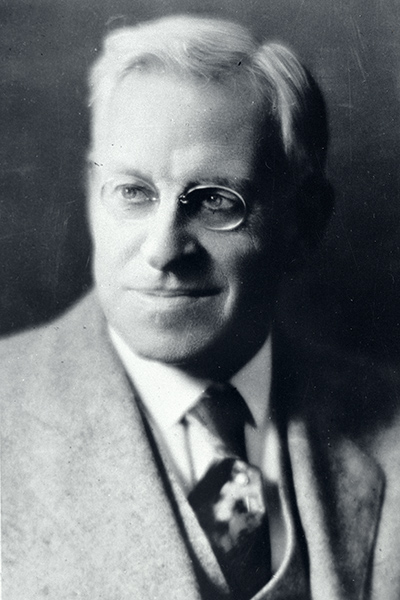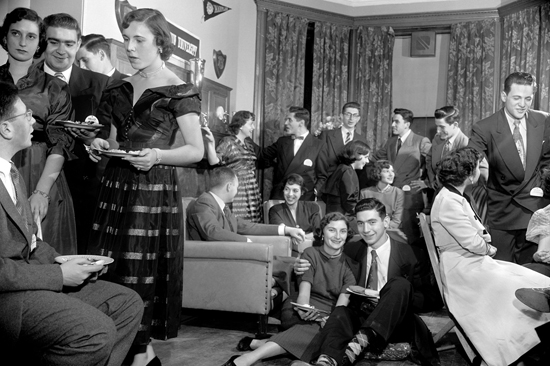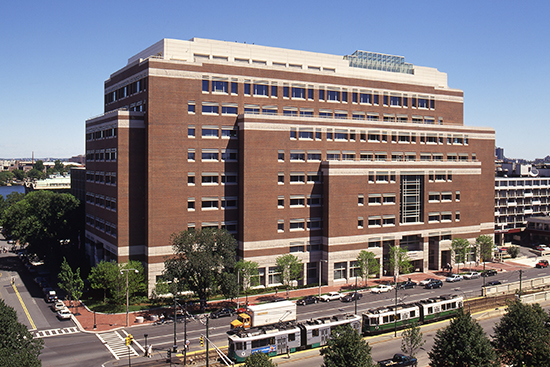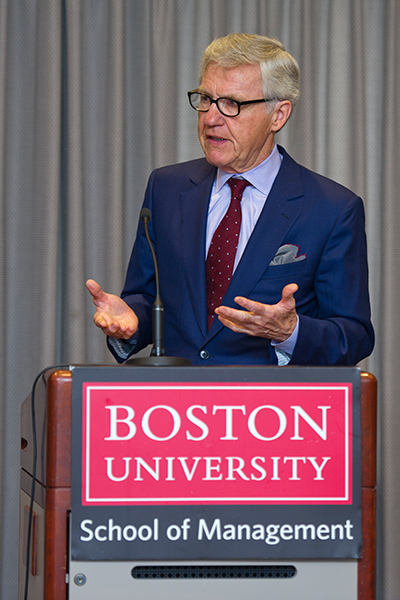The Birth of a College
How a pro-male movement at BU led to New England’s first business college

In 1916, the College of Business Administration moved to the newly renovated Walker Building at 525 Boylston St. in Copley Square to accommodate a growing student body. Photo by BU Photography
Men, men, men. That’s what the relatively small number of male Boston University alumni wanted to see more of at their alma mater. It was the early 20th century, and graduates of the previous century were galled to learn that some were calling BU a “girls’ college.” Indeed, the Class of 1910 numbered nine times more women than men.
A group of these concerned alumni formed the “More Men Movement” at BU and commissioned a survey of local high school boys to learn what sort of postsecondary education they wanted. The collective response: practical courses that would train them for careers in business.
Next, the alumni asked local business leaders what those boys would need to be prepared for the commercial fields. The executives’ answer: courses in accounting, finance, and business principles, as well as the cultural grounding of a traditional college education.
Was it possible to give students both? It certainly wasn’t the norm in 1910. But the More Men alumni proposed a solution, one that would put BU on the crest of a sea change in American higher education.
A demand exceeding supply
The generation of silver-haired men then at the helm of American business had seen and been part of a revolution in transportation, communication, and production. Plenty of these industry leaders were self-made men who had succeeded without the benefit of a formal education. Others had gone to college, but, particularly in stodgy old Boston, that meant they had received a classical education on the 17th-century European model, befitting men of their station. Once in their jobs, these newly minted scholars found their experience translating Pliny had little immediate relevance to importing sugar.
That somewhat loosey-goosey system of producing a merchant class made less and less sense as the 19th century progressed and the 20th began. The dual march westward of railroads and telegraph lines resulted in a truly national economy, complete with chain stores, mass marketing, modernized factories, and major investment banking.
With this enormous network of intertwined commercial activities developing, too much was at stake to leave its continued success dependent on pluck and luck.
“More than ever before is the demand for competent men in excess of the supply,” wrote efficiency expert Frederick W. Taylor in 1911. “What we are all looking for, however, is the ready made competent man; the man whom someone else has trained.”
Enter, someone else

Boston University and a few other pioneering institutions, such as Dartmouth College and the University of Pennsylvania, would take it upon themselves to do the training that everyone was hoping someone else would do.
It wasn’t an easy sell. When Everett W. Lord (CAS 1900, GRS 1906, Hon.’60), leader of the More Men Movement, pitched a business program to BU’s trustees, the very concept of business education suffered from a bad reputation in academia, thanks to that era’s sketchy underworld of unaccredited correspondence schools. The faculty of BU’s College of Liberal Arts (CLA), now the College of Arts & Sciences, was almost uniformly opposed to Lord’s proposal. Current BU Professor James Post has uncovered documents of the debate in which professors described the idea as “impractical . . . contrary to the principles of Boston University . . . undesirable . . . unacademic” and (paradoxically) “unbusinesslike.”
Lord, however, argued that situating a course of business study within BU’s humanities curriculum would serve not only students, but society as well. His focus on the well-being of male students may seem narrow today, but for his time, Lord was a socially conscious progressive—which helps explain his interest in business education. (In Transformations: A History of Boston University, author Kathleen Kilgore also notes that Lord’s call for more men struck a markedly different tone from many other institutions facing dwindling numbers of male students. Based on “sex repulsion theory,” they tried “devising ways of excluding women.”)
After spending his youth as a cook at sea, Lord attended CLA, graduating in 1900. He worked as a teacher, then a school administrator, in his native rural Maine before moving to Puerto Rico. There he helped develop a public school system and became an advocate for fair treatment of the island’s people. In 1908, the National Child Labor Committee hired Lord as its New England secretary, and he helped curtail the abuses in Maine’s sardine industry, which had been employing seven-year-olds to work 12-hour shifts handling 18-inch knives (often resulting in gruesome accidents).
Lord was part of a national backlash against such Gilded Age excesses. Even rank-and-file businessmen soured on the laissez-faire era: the monopolies stifled competition, and the rampant speculation caused repeated depressions.
For an incipient school of business education, that meant graduates should go into the world with both nitty-gritty business know-how and a big-picture understanding of how their industries fit into the economy and society at large.
“This college maintains the theory that in a capitalistic democracy our leaders and executives, and, indeed, all our voters, need an intelligent appreciation of capitalism in its relation to democracy and human welfare,” Lord would say years later.
School in session

The BU trustees and president approved of Lord’s business program on the conditions that funds come from outside sources, and that it be a night school separate from CLA (although it would use CLA classrooms in Copley Square, after hours). Massachusetts Governor Eugene N. Foss and Boston Mayor John F. “Honey Fitz” Fitzgerald (grandfather of future US President John F. Kennedy) bought the first bonds for the new College of Business Administration (CBA). Lord himself became the college’s first full-time dean.
The first CBA classes were held in October 1913. The college enrolled 274 students—including 40 women—that year. The most popular courses were Elementary Accounting, Commercial Law, Commercial Composition and Business English, and Economics.
The college’s rapid growth reflected the demand. In its second year, 425 students enrolled, and tuition revenues exceeded expenses; Honey Fitz and the rest of the bondholders were repaid. The trustees were soon convinced the college was a viable entity deserving a bigger commitment of resources. They authorized expanding CBA into a full-time program, making it the first undergraduate college of business in New England.
Enrollment leapt to 1,438 students in the 1916-1917 academic year. Cramped in the CLA space, CBA moved to its own Copley Square headquarters. The college’s first day class graduated in June 1917, just months after the United Sates entered the First World War.
Weathering a crash

Enrollment rose again after the Armistice in November 1918, as veterans used their service bonus money for tuition, and the movement to professionalize business education gained momentum as the consumer economy boomed throughout the 1920s.
After the stock market crash in 1929, enrollment declined across BU. However, Lord commissioned more surveys, this time showing the value that employers placed on a college degree. CBA’s enrollment declined the least of any school or college at BU.
Lord would later point to the success of CBA graduates in finding employment even in 1932 and 1933, the nadir of the Depression. In 1938, he told the Christian Science Monitor that business colleges had vitalized higher education by creating competition with the liberal arts, while graduates had raised the national standard of business education by taking teaching jobs at smaller institutions. Finally, academic research units, like BU’s Bureau of Business Research, had supplied chambers of commerce and other business organizations with some of their most dependable economic information.
In September 1939, a few weeks after Nazi Germany invaded Poland, CBA was the first BU school to move to the new Charles River Campus. Its new home was the five-story limestone Charles Hayden Memorial at 685 Commonwealth Avenue. Lord would retire in May 1941, seven months before Imperial Japan bombed Pearl Harbor.
Nominal and actual change

After the postwar G.I. Bill bubble, CBA’s enrollments declined in comparison with those of BU’s other schools. The college fell victim in part to the very competitive atmosphere it had helped create, in part to a manufacturing decline in New England, and in part to the departure of its advertising and news reporting courses for BU’s new School of Public Relations (now the College of Communication).
In 1971, new BU President John Silber (Hon.’95) asked consultant Peter Gabriel of McKinsey & Co. to study the University’s strategic future. Silber was so impressed with Gabriel that he hired him as the dean of CBA in 1973.
Over the course of that decade, the school (it made the switch from college to school in 1974) added master’s degree programs—in manufacturing and business administration, including MBAs in health care management and public management—as well as a doctoral program in business administration. In the years since, it has adapted to advancing technology and a globalizing economy with a master’s program in information science, a program in management practices in Asia, invaluable research centers, and other initiatives.
Under long-serving Dean Louis Lataif (Questrom’61, Hon.’90), the school moved in 1996 to its present home, the spacious and state-of-the-art Rafik B. Hariri Building at 595 Commonwealth Avenue. In his 19 years at the school, Lataif brought a new emphasis on team learning and teaching and the introduction of a cross-functional curriculum.
The semantics have changed over the course of a century. Today you’re more likely to hear the current dean, and former Quest Diagnostics CEO, Kenneth W. Freeman, Questrom Profesor and Dean of Management, talk about how the newly rechristened Questrom School of Business “creates value for the world,” rather than how it provides a “service to society,” as Lord did. But the meaning is the same, and so is the mission.
Moreover, the demographics have changed. Students come from around the globe, and the student body is 45 percent female, a far cry from . . . Wait a minute—less than half? Perhaps as the next chapter begins, it’s time for a More Women Movement.
A version of this article originally appeared in Everett, the Questrom School of Business newsletter.
More on the Questrom Gift
- Record Gift Renames SMG Questrom School of Business
- Retail’s Power Couple
- Questrom School of Business Faculty, Students React to Gift
Comments & Discussion
Boston University moderates comments to facilitate an informed, substantive, civil conversation. Abusive, profane, self-promotional, misleading, incoherent or off-topic comments will be rejected. Moderators are staffed during regular business hours (EST) and can only accept comments written in English. Statistics or facts must include a citation or a link to the citation.